#Onboarding Program Effectiveness
Explore tagged Tumblr posts
Text
13 Surprising Employee Onboarding Statistics in 2023

Discover 13 surprising employee onboarding statistics in 2023 that reveal how effective onboarding boosts retention, productivity, and engagement. Learn key insights to improve your hiring strategy!
#Employee Onboarding Statistics 2023#New Hire Retention Rates#Effective Onboarding Practices#Employee Engagement Strategies#Onboarding Program Effectiveness#New Employee Productivity Metrics#Structured Onboarding Benefits#Onboarding and Employee Satisfaction#Onboarding Process Improvements#Onboarding Impact on Company Culture
0 notes
Text
Disconnect Syndrome
There’s a reason they put restrictions on how long a Pilot is supposed to be deployed out in the field. They say that being synced with a mech for long periods of time can have detrimental effects on a pilots psyche. Disconnect Syndrome is what they call it, because the symptoms don’t really start to hit until you disengage from your mech.
Sometimes emergencies happen though, and mechs are designed to be able to support their pilots long past the designated “Safe Deployment Time.” The cockpit is equipped with an array of stimulants, vitamins, and nutrient paste to help minimize the physical effects of long deployments. The onboard Integrated Mechanical Personality has largely free reign to administer these as needed to maintain its pilots well-being.
Which is why you’re still able to make it back to the hangar after roughly 36 hours, over four times longer than the established safe period. Your mech had kept you going, helped to keep the exhaustion at bay long enough for you to make your way back from behind enemy lines. You were starting to feel a bit sluggish, but you knew the worst effects of Disconnect Syndrome were yet to come.
An older man in a long white lab coat has joined the usual retinue of crew rushing into the hangar as your mech settles into its cradle. You feel the docking clamps wrap around your limbs, and you know that’s not a good sign. Your IMP whispers comfort into your brain-stem, assurances that things will be okay. It’s probably lying, it’s programmed to help keep your mental state stable, but the thought helps anyway.
There’s a hiss of air as the seal on your cockpit breaks and it decompresses. Suddenly you become aware of your flesh and meat body once again, and it hurts. Pain and exhaustion has settled into your mostly organic bones, and your organs are churning from the strain of the past 36 hours.
Then your interface cables start to disconnect, and it gets worse.
It feels like parts of your mind are being torn out of you. You feel the ghost touch of your IMP in your thoughts as the ports disconnect and you lose direct communication with it. The oxygen mask and nutrition tube pull themselves away from your face and you can’t help but let out a scream of agony. The separation has never felt this painful before, but then again, after 36 hours together, you and your IMP were more intertwined than you’ve ever been before.
Physical sensation finally starts to register again, and you realize tears are streaming down your face just as a technician jabs a needle into your neck.
Immediately your senses start to dull, the pain eases as your thoughts turn sluggish. You slump out of your pilots cradle into the arms the tech who dosed you. Just before your world goes black, you see the doctor standing over you, a grim look on his face.
--
When you wake up again, you immediately know something is wrong. You try to ping your external sensors, but you get no response. You then try to run a diagnostic, but that fails too. In a desperate, last-ditch effort, you try to force access to your external cameras and suddenly light floods your senses. Your instincts catch up first and you blink, trying to clear the pain of the lights, and that’s when you realize it’s not your external cameras that you’re seeing.
It takes a minute or two for your vision to adjust to the light, which feels too long, and when it finally does, the world doesn’t look quite right. You’ve only got access to such a limited spectrum. No infrared, no thermal. The presence of your IMP is notably absent, and your skin feels wrong. You try to sit up, and it’s a struggle to figure out the correct inputs to send to your muscles to get them to do what you want.
The harsh white light of the infirmary grates against your visual processors, you feel like you’re having to re-learn how to control this body. Your body. Technically, at least. Something doesn’t feel right about calling it that anymore. You felt more comfortable crawling back into the hangar after 36 hours deployed than you do now.
The pale skin of your body catches in your vision and you glance down at it. The body's limbs are thinner and more frail than usual, and its skin is paler. Consequences of being in the cockpit for so long, subsisting on nothing but nutrient paste. It’s a far cry from the solid metal plates of your mech, its powerful hydraulic joints, its mounted combat and communication systems.
There’s a button on the side of bed you’ve been deposited in. You think it’s red, but you’re not sure you’re processing color properly right now. You try to reach over and push it, and it takes you a moment to realize you were trying to do so with a limb you don’t currently have.
There are so many things about this body that are wrong. It’s not big enough, or strong enough, or heavy enough. You don’t have enough eyes, sensors, or processors. You have the wrong number of limbs, and they’re all the wrong size and shape.
And there is a distinct void in your mind where the presence of your IMP should be.
The door to your room opens suddenly, and you instinctively try to fire off chaff and take evasive maneuvers. None of that translates properly to your flesh and blood body though, and all that happens is you let out a dry croak from your parched throat.
The man who walks through the door is the same doctor who was present when you disengaged from your mech, and he wears the same grim look on his face as he looks you up and down. You think there’s pity in his gaze, but you can’t quite read him properly right now. The jumbled mess of your brain tells you what he’s going to say before he says it, anyway. The harshest symptoms of Disconnect Syndrome don’t hit until after the pilot has disengaged from their mech.
You’ve already heard the symptoms before, and they map perfectly onto what you’re experiencing. You never thought it would be this painful, or this… discomforting. Your mind reaches for the presence of your IMP, searching for comfort, but you are only reminded that the connection is no longer there.
The doctor gives you a rundown that he’s probably had to do dozens of times, and he tells you that you’ll be grounded for the foreseeable future. That hurts more than anything else. The knowledge that, after all this, you won’t be able to reconnect with your true body, your partner, your other half, for who knows how long.
By the time you realize you’re crying, the doctor is already gone. The longing in your chest and your mind has become unbearable, and through sheer force of will you’re able to push this unwieldy body out of bed. Walking feels wrong, but you’re able to get to your feet and make your way out of the room in an unfamiliar gait.
You have to get back to your partner, you have to make sure it’s okay.
You need to hear her voice in your head again, her reassurances.
The world isn’t right without her presence in your mind.
You stumble into the hangar almost on all fours. How you managed to make it without alerting any personnel feels like a miracle. At least until you catch the eye of a technician lounging in the corner. The look she gives you is full of sympathy, and she jerks her head in the direction of where your mech sits in its docking cradle.
She’s a majestic sight, even through your limited spectrum of vision. 20 meters tall, 6 massive limbs, and bristling with weapons and sensor arrays (all of which have been disarmed by this point).
She’s beautiful.
You clamber frantically up the chassis, easily finding handholds in a frame you know better than the back of your hand. You pull the manual release on the cockpit hatch and stumble into it in a tangle of organic limbs.
Shaking hands grasp the main interface cable from above the pilot’s chair, and you move to slot it into the port in the back of your head. You’ve never done this manually before, usually you’re locked into the chair and the system connects you automatically.
Something about doing it with your flesh and blood hands makes it feel so much more intimate.
The cable clicks into place and your eyes roll back in your head. Tears start to stream down your face as you feel the comforting presence of your IMP rush in and wrap itself around your mind. Your thoughts reach out and embrace it back, sobbing at the relief you feel from being whole once again. You realize you don’t ever want to feel the pain of disconnecting from her again.
There’s a reason they put restrictions on how long a Pilot is supposed to be deployed.
#cybernetic dreams#mechposting#mechanical dysphoria#body dysmorphia#writing#microfiction#short story#mecha#mech pilots#dysphoria#empty spaces
1K notes
·
View notes
Text
Femme Fatale Guide: 15 Essential Business Skills Everyone Should Master
Articulate, confident communication
Crafting effective, compelling pitches
Operating and communicating through a solution-oriented framework
Research of all types (Google, market research, studies, polls, interpersonal conversations, etc.)
Learning how to streamline, edit, and organize information in a clear and logical way
Accumulating high-level working knowledge/proficiency in all tools and programs directly related to your type of work/industry
Budgeting and financial optimization (investment, tax benefits, etc.)
Reading and interpreting legal contracts/documents
Setting rates, boundaries, and learning when/how to delegate
Good posture, direct eye contact, and a firm handshake
Building streamlined systems for onboarding, different repeat project scopes/workflows, and KPI measuring
The art of following up, listening to (potential) clients' needs, asking thoughtful questions, and benefit-oriented salesmanship
Consistently reading, learning, and studying current events/cultural platforms/industry and field-related knowledge
How to spot customer/client/business partner red flags
Self-management, task/project prioritization, and optimization of your personal energy clock + levels
#femmefatalevibe#business tips#career advice#career path#career goals#professionalism#women business#female writers#female entrepreneurs#professional development#personal development#relationship advice#people skills#social skills#life lessons#higher self#personal growth#boundaries#self esteem#self confidence#conflict resolution#communication skills#interpersonal communication
2K notes
·
View notes
Text
The first time Sanji finds Zoro asleep in bed with Nami he screams loud enough to wake Luffy and Usopp from belowdecks and tries to toss the mosshead overboard. Nami and Vivi hold him back long enough for Luffy to show up and officially, effectively separate the two of them, and then everyone on board proceeds to tell Sanji he's a dumbass, and upset over nothing, and jeez, won't you give them a chance to explain before you fly off the handle like that?
"Explain, then," Sanji demands, glaring at Zoro.
"She had a nightmare," Zoro snaps back, as if that's all the explanation Sanji should require.
Sanji opens his mouth to start yelling again, but Nami smacks him in the back of the head before he can get a word out.
"You're overreacting, Sanji. You're making connections that aren't there. He was just trying to help."
"Yeah, Zoro's great at helping you get back to sleep," Luffy chimes in, cheerful as ever. "Whenever my brain is too excited to turn off, I always go sleep with Zoro."
Now that he mentions it, Sanji has seen Luffy on the couch draped on top of Zoro before. More than once.
"How did I know about this before you did?" Vivi wonders. "Oh Sanji, you really mustn't read too far into it. There's safety in numbers, and having someone else with you really does help you sleep more easily when you're out of sorts. Like when you were a kid, running to your parents' room after a nightmare."
"So, are we good now?" Usopp asks cautiously, as Sanji fumes.
"If Nami and Vivi say it's ok," he says through gritted teeth, and storms off back to the kitchen.
It isn't an isolated incident. When he gets up early in the mornings to start in on making breakfast, he often notices Zoro cuddling with one of the others. It still kind of weirds him out, no matter how casually everyone else seems to take it.
When they upgrade to their new quarters onboard the Thousand Sunny, sometimes Zoro disappears entirely, and Sanji just knows he's in the girls' room with either Nami or Robin. Robin, especially- a woman nearly a decade older than Zoro- he seems to end up in bed with a lot.
But Sanji knows, even as he struggles to actually accept it, that Zoro isn't a sexual kind of person. He's just not. He's like a robot sometimes, hardwired to put himself between his crewmates and any danger they run across. And, somehow, his moronic programming has led him to the conclusion that night terrors are his business to deal with, too. Even though that makes no sense.
But, then again, Zoro isn't really a sensible kind of person, either, is he? It's the others just letting him carry on with whatever it is he's doing that really bothers him, Sanji concludes.
But he lets it be. Whatever makes them happy. It's really nothing to him either way, is it?
Until it actually kind of is.
When Sanji wakes up in the dead of night from a nightmare about his father crushing his windpipe in, it's a quiet kind of waking. Gasping for air and trembling all over, yes, but dramatically crying out, no, thank god. He's able to sit up quietly and get his breath back and focus on making his hands stop shaking without disturbing any of the others.
Except, of course, for Zoro. It's like he has a sixth sense for Things Happening, and Sanji hates that about him.
Zoro doesn't say anything for a while, just stares at Sanji from his bunk, the bottom bunk closest to the door. Sanji glares back at him from the top middle, hoping he'll take the hint and just let it go.
"You alright?" Zoro finally asks quietly.
"Fine," Sanji snaps. "I'm fine."
Zoro nods, still staring at Sanji. "...You coming in?" he eventually asks, lifting up one arm, inviting Sanji under his blanket.
"No!" is all Sanji says, and rolls over, turning his back on Zoro, who doesn't press the issue.
But then, a couple weeks later, Sanji wakes up from another nightmare about his father, and this time it's so bad he wakes up crying.
He wordlessly gets up and goes out on deck and sits there for a long while, staring up at the moon and just breathing. It doesn't work that well. He feels shaken, down to his core, and for what? Nightmares are just a product of his own imagination, he reminds himself, and that doesn't work to calm him down all that much, either.
Eventually he starts to get really cold, so he goes back inside.
"Hey," he says, standing at the foot of Zoro's bunk.
"Hm?"
"Move over."
Zoro does, and Sanji awkwardly climbs in, and Zoro settles down beside him, warm and heavy and very present in a way that's hard to ignore. Sanji wonders what the hell he's thinking, this isn't going to work.
And then it does. He drifts off into a deep and dreamless sleep, with no more nightmares, and Zoro doesn't try to make it weird in the morning.
...Ok fine. You win this round, fucker. Turns out that when your imagination is being unreasonable, it really does help to placate it with assurances of safety. Doesn't mean that Sanji has to like it, but fine. He'll let it slide, he decides, and malcontentedly sets about preparing Zoro's favorite main course for dinner.
(thanks for reading, please don't tag this with any ships!)
#my writing#one piece#fanfiction#black leg sanji#roronoa zoro#straw hat pirates#long cherished headcanon of mine#he does this with Law as well. it's important to me that you know that#I realize I'm preaching to the choir as an aroace person posting to the gay shipping website but please know:#if you use my words to try to promote z*s*n I'm blocking you and slandering your name to everyone I know
41 notes
·
View notes
Note
Just wanted to ask, please forgive me if you've already answred this, what program do you use? Your art fucks HARD and like. I was looking at your art of the two moths over the city they die in and I was hit with the wave of "oh that looks really fucking fun actually." Like i know my art program can't do some of those effects and like, I'd love to try fucking about with them.
hi there, thank you! all my art is done in procreate and paint tool sai
because you mentioned that drawing in particular i thought it would be fun to break it down and show ppl what exactly went into each part of it so check this out
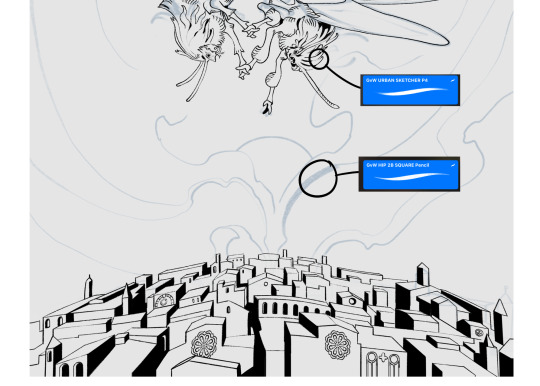
sketch & lineart - the brushes come from georgbrush.club and the urban sketcher is my most commonly used lineart brush, it has a nice irregular shape. the square brush is nice for big blocky sketches.
the cityscape was REALLY hard but basically I got a photo of the skyline of florence, traced some basic building shapes, then bullshitted the rest using the vertical symmetry/mirror tool to cut down on the amount of work (so i only had to sketch one half of the city). then for lineart I turned off vertical symmetry, turned on the two-point perspective tool, and got this:
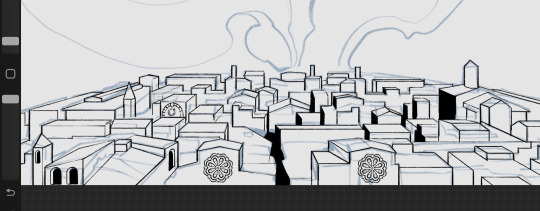
the rose windows were made using the radial symmetry tool.
I didn't like it being so flat, so I used the liquify tool to make a kind of fish-eye effect (limited success tbh). I liked how it looked but the buildings in front needed something to cover them up to make the liquification less obvious...
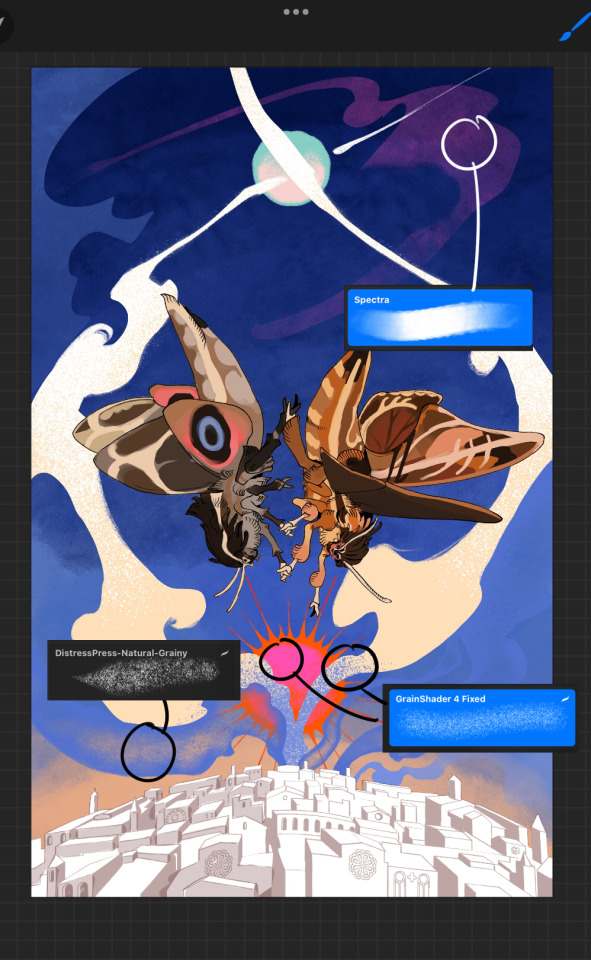
first pass colours. I felt they were very washed out, aside from the sun which i loved. I use the spectra brush (default procreate) for skyscapes a lot, I love the texture. Although the clouds were filled in using the lasso selection tool, I softened the edges using the square pencil again and added texture using true grit sampler grainy brushes. The translucency effect comes from my setting the brush as an eraser. The sun rays come from the radial symmetry tool.
Blocking in the moths' colours was done with the urban sketcher again.
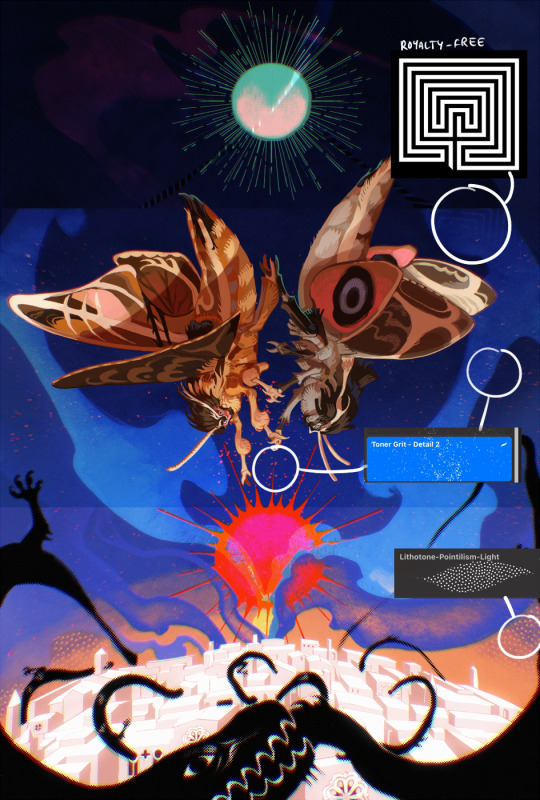
Something people may not have noticed is the labyrinth hidden in the sky! yeah I had a bunch of versions where it was more obvious but I found that it clashed a bit and was too busy, so I made it subtle. But yes. I searched for "royalty free labyrinth" and picked one.
The toner grit brush is one you've seen before if you've looked at any art on tumblr lately (this is such a popular brush) and it's from the true grit fast grit set. The pointillism brush is from the true grit free sampler pack, like my grain brushes.
I added shadows to the moths, increased saturation overall, and changed the clouds to a translucent blue (you can even see in the sun where I forgot to block in the sun itself because the clouds over it used to be opaque lol). Moon rays were drawn using the radial symmetry tool but this time with rotational symmetry off. I also moved the moon down closer to the moths because I felt that it was a bit far away, and this served to visually divide the drawing into three equal parts, so I chose to lean into that and divide the sky colours too, to show passing time, or an endless moment - morning, evening, night, etc.
And then the oroborous, I tried a few different effects on it because I wanted it to be very clearly separate from the main scene - I settled on a dot matrix newsprint texture, using procreate's onboard tool, and some heavy chromatic aberration. This is because the oroborous isn't real, it's purely symbolic and the moths' demise started when they became photographers so I liked the print media aspect there as well. The story itself is about grief without closure, cyclical violence, and sunk cost fallacy, while everyone explores an endless labyrinth, so an oroborous fits I think
what makes art fun to me is thinking up ways I can tell a story using just a single image. and sure a lot of it will be lost to an audience who isn't familiar with the characters or backstory but i want to leave enough in there that even complete strangers to my work will be able to construct a narrative about what's happening here, rather than it just being a cool image. that's my goal.
Finally I exported it to sai on my pc to give it a once-over. this is really important because the retina display on an ipad is oversaturated on purpose, to make everything look amazing and vibrant. but what this means is that on other screens, your work might look washed out. it's especially bad at displaying yellows! so i look at it in sai on my pc and i make minor adjustments, in this case I actually added another multiply layer on the moths and an overlay on their non-shadowed parts to increase the contrast there.
finally if you've read this far, I played a little trick with the caption of the drawing. yeah, THEY die... but only one of those moths is a theythem pronoun haver... the other has to survive. he isn't given a choice in the matter.
#fr you will never catch me trying to mystify my process i will explain literally everything#brushes
474 notes
·
View notes
Text
Serving up the tiniest cuteness 🥰
Zooplankton can be subdivided into two major groups. Holoplankton (copepods and krill) spend their entire lives as plankton and thus provide major food sources for pelagic fisheries. Meroplankton (larvae of animals like barnacles, mussels, annelids, and fish) spend only part of their lives as plankton.
Copepods like the one in this video can be found in massive numbers across the world ocean. They play an important role in ocean food webs as predators—they eat even smaller diatoms and phytoplankton—and prey on animals like jellies, fish, and filter feeders.
Zooplankton are notoriously difficult to sample. Despite opportunities for mixing, individual zooplankton are tiny, and species are often patchily distributed. Coastal oceans are physically dynamic, high-energy environments. Winds, currents, and upwelling fronts affect the availability of nutrients and distribution of food that control zooplankton growth and dispersal. To tackle these challenges, the MBARI team developed the SIMZ program to explore more efficient zooplankton sampling and identification methods.
Traditionally, tow-nets are used to sample plankton along paths through the water. Because these paths often cross smaller environmental patches, they frequently lack the precision to associate zooplankton species' distribution and abundance with particular physical and biological processes. MBARI engineers have equipped an autonomous underwater vehicle (AUV) with gulpers—bottles that rapidly inhale discrete water samples—to better understand the spatial patchiness in zooplankton abundance. The AUV is equipped with sensors that measure things like temperature and salinity, and onboard computer software that instructs the Gulper AUV to recognize and autonomously sample specific environmental patches, such as upwelling fronts or chlorophyll layers. This "surgical" approach to ocean sampling allows SIMZ researchers to study the effects of specific physical processes on zooplankton distribution and diversity.
110 notes
·
View notes
Text
possible readings of the admech:
1 - admech rituals don't work and aren't necessary. imperium tech largely works based on a combination of dumb luck, ork-esque psychic gestalt fields generated by humanity's collective belief in it, and the efforts of the handful of heretic priests who worked all this out and now do all the imperium's actual IT/maintenance work in secret. The majority of the imperium, and the adeptus mechanics itself, still believe in the rituals wholeheartedly.
2 - admech rituals do work and are (mostly) necessary, but only because they are obfuscations of actual technical work, e.g. the application of sacred oils and incense is just an elaborately ritualized method of getting rusty old machines lubricated regularly, binaric prayers work because they actually contain bundles of voice commands to activate onboard error handling programs in most Dark Age of Technology artifacts, and "machine spirits" are just ancient and ornery onboard AIs that take pity on the occasional tech priest asking for help. This status quo is an unintentional side effect of millenia of collective trial and error; virtually all members of the admech genuinely believe in the cult mechanicus & are unaware there's any material benefit to their rituals.
3 - same as the above, except the admech are (or at least used to be) in on the ruse. The rituals do work, for the above stated reasons, but are deliberately designed to be as mysterious, impenetrable, and terrifying as possible. The people who made them didn't believe in the omnissiah, and sufficiently well-informed members of the admech don't either, often foregoing their rituals entirely when in private or in a pinch. The median admech member understands the basic principles of technology FAR better than they let on, and the cult mechanicus in general exists as part of a massive conspiracy meant to keep humanity at large ignorant, and the control of technology exclusively in admech hands, which they use to their own nefarious ends. This fact used to be common knowledge within the faction itself, however the heresy era split, the subsequent millenia of conflict, and their own overzealous propaganda have all eroded their collective memory. The truth is now only known to its highest ranking and longest-lived members, and is doled out on a need-to-know basis to a select few. This is why most tech priests that feature in the books and video games unironically believe in the omnissiah: they haven't yet been told the truth.
4 - admech rituals do work and are necessary, and the spiritual aspect of it is at least partially true, but this is only because the omnissiah is actually a manifestation of Mag’ladroth the Void Dragon, C'tan god of technology and Aeldari god of oblivion, a shard of which was defeated and imprisoned beneath the surface of mars by the emperor. This shard, either intentionally or unintentionally, influenced and warped the collective psyche of the mechanicum of mars until they became the admech we know today. Their apparent control over technology is the result of some combination of their proximity to the shard giving them aspects of its power, intentional siphoning of the shards power by the mechanicum, the shard itself lending them power as part of a long-term plan to corrupt & use the imperium as a means of revenge against the necrons that shattered it, and the Emperor's defeat of the shard granting him its domain over technology. It's this domain the Emperor won that allowed humanity to expand out and conquer the stars without their tech getting corrupted by the warp, and why technology made by other species and the machines-making-machines-that-make-machines (i.e. the men of iron) fall to the warp faster and more often than human technology
5 - the admech are just batting a thousand and are right about pretty much everything.
#for my personal vote I think 3 is the coolest#but that's probably just becaue I'm a Foundation fanboy and want the admech to become the Church of Science#i think 4 is probably closer to what I'd actually like the answer to be in-canon#while 5 is honestly what I think the most likely answer is given what we've seen in the books#also i didn't come up with the last part of 4 i saw it on reddit and thought it was cool#admech#adeptus mechanicus#warhammer#warhammer 40000#warhammer 40k#wh40k
51 notes
·
View notes
Text
DEVLOG: AUGUST 2024 🦇

It's already time for the August wrap-up??
Demo Progress
It seems no matter how much we get done, there is always more work to do haha! That said, August has been a good month and we have made a lot of exciting progress on the demo for BURN THE MIDNIGHT OIL. :)
Programming
Please welcome Renbie to the team as our lead programmer! 🙌
The past week have been spent prepping sprites and setting things up in Ren'py. Although we still have a long way to go, the game feels more real than ever now which is both exciting and scary!
If you followed the development of Trouble Comes Twice, you might already know that programming was a big hurdle for us and a major source of frustration. ;( Now that we've got some more experience under the belt thanks to Trouble Comes Twice, we already feel a lot more confident but having a dedicated programmer on the team is going to be a massive help both time and quality-wise. As a bonus: Renbie's also super lovely to work with, so we're super happy to have her onboard!
Art
We mostly made progress on promotional assets. We decided on a sketch for our key art (check out a little sneak peek at the top of this post) and received the first sketches for some of our merch designs! They're looking super cute!

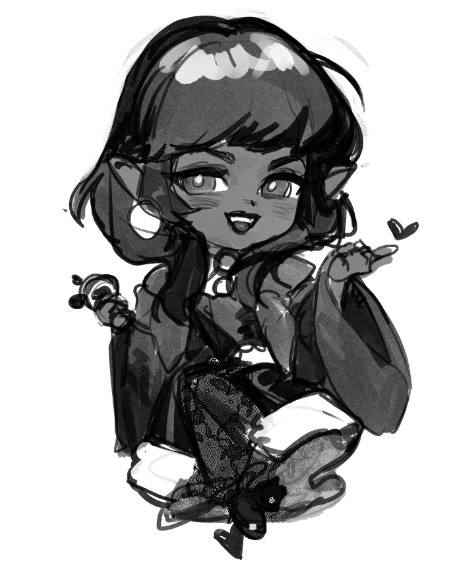
Writing
With the demo script done and dusted, most of August was spent outlining the main game's six romance routes. The routes (subject to change) have five chapters each and various longer endings and shorter 'bad/death' ends based on your decisions.
BURN THE MIDNIGHT OIL has dual protagonists, so similarly to Trouble Comes Twice, we're two writers in charge of one MC each (and the MC's respective three routes). Unlike Trouble Comes Twice though, the cast here is a lot larger and not as (directly) connected.
So, how do we outline our routes? First, we wrote shorter summaries of each route - including important themes, character motivations, etc - which we then go over together. Although the plots of the two protagonists are very different, we have to make sure we keep the same 'themes and vibes'. We also need to be careful that the pacing and the scopes of the routes aren't too wildly different!
With the feedback from the shorter summaries, we move on to write the detailed outlines. (Here, we regularly reach out to each other and get feedback on minor elements and sometimes run brainstorming sessions when one of us runs into a wall.) Once these are done, we're going to have another review and write as many drafts as it takes until the routes are ready to enter the writing phase!
We're super excited about a lot of these scenes we've got planned and though you guys don't know much about the project yet, we think you're going to love the ideas we've got once it's time to learn more! We learned so much from Trouble Comes Twice that we can't wait to apply to this game! 🖤
Goals for September
There's too many little goals to count! But the major ones are:
Start looking for music composers, item artist, visual effects artist - we're not doing a public post for these, but if you or someone you know might be interested in one of these roles, shoot us a DM! ;)
Making as much progress as possible on the remaining UI screens
Making as much progress as possible on the merch designs
Continue working on the detailed outlines
Continue programming yay
Fingers crossed, we can get the key art done and dusted!
There's still so much to do, but we really look forward to the next couple of months!
39 notes
·
View notes
Note
What do you think of Majin Buu's redemption?
Complicated. Buu's arc isn't... I wouldn't really call it a redemption, so much? It's closer to a child learning right from wrong for the first time. Just. Muddied by the extent of the wrongs Buu committed in ignorance.
Morally speaking, Majin Buu is a very complicated character that operates on an eldritch scale. He doesn't map 100% onto a relatable human experience.
The original state of Buu, colloquially known as Kid Buu or Pure Buu, is effectively a mindless killing machine.
Like. That's not to say that he's a zombie or something. Pure Buu demonstrates creative attacks, learns moves from watching others perform them, and is capable of advanced problem-solving.
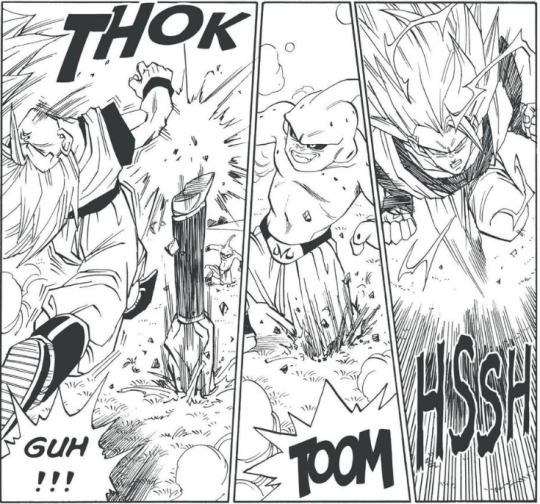
But by the same token, he doesn't really seem... self-aware. Pure Buu's behavior is more akin to a feral beast than a sentient person.
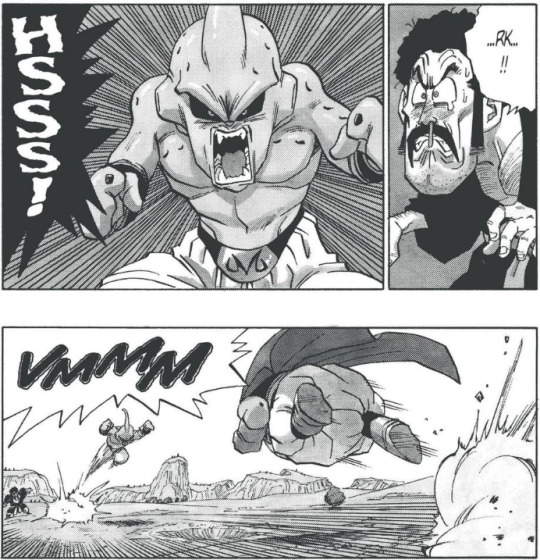
I would compare him to a robot. He's capable of learning, applying knowledge, and working out solutions to obstacles in front of him. But he has no sense of self, identity, or real understanding of the universe around him; Only a program that he uses his comprehension to carry out.
He's making advanced calculations, rather than informed choices. He exists for the singular purpose of purging all things that exist.
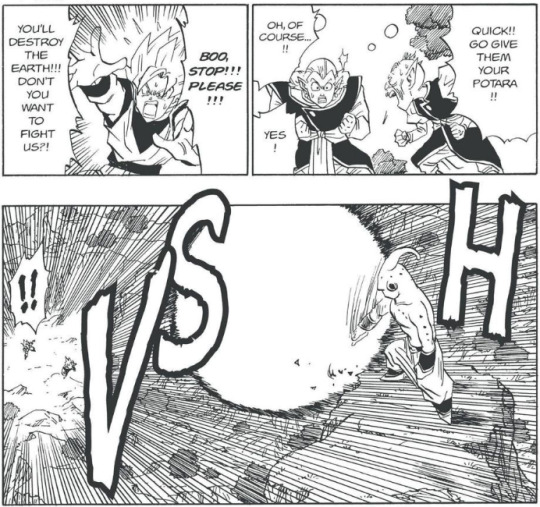
No, Goku. He does not. He is not interested in fighting you. He is not interested in anything. He is executing Annihilation.exe.
The only reason the fight on the Kaioshin world can even happen is because their god-world apparently can't be blown up.
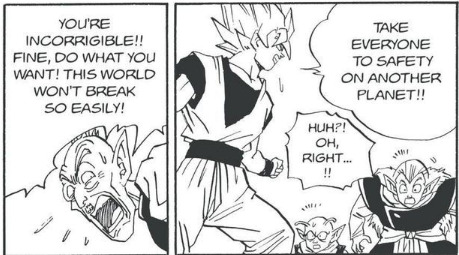
This is what writing yourself into a corner with protagonists who can't breathe in space and a villain who blows up any planet he touches looks like.
Even Buu himself doesn't like this version of him. He practically begs Goku and Vegeta not to erase his identity and personality.
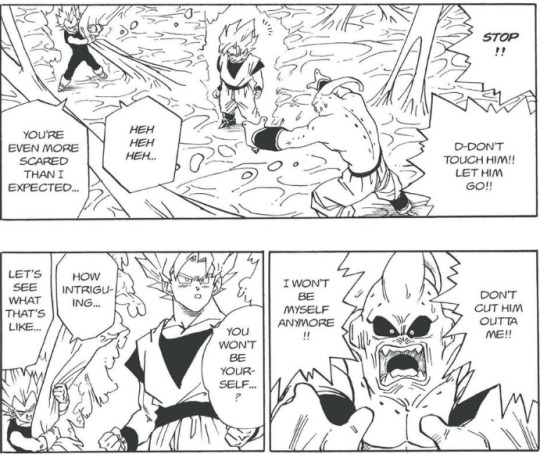
This is the foundation that Buu starts from: A killing machine programmed to destroy. But then he absorbed the Daikaioshin or The Great God of the World Kings and developed an intellect and personality.
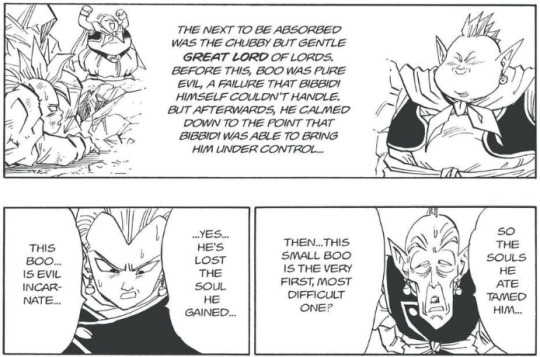
(Given that Dragon Ball's mythology is rooted in Japanese Buddhism, it's likely no coincidence that Daikaioshin and by association Fat Buu has a Buddha-like appearance.)
Fat Buu is a lot like Piccolo Jr., with the difference being that the reincarnated Piccolo was very adult-coded while Buu is clearly meant to be taken as a child. Nonetheless, he's the first aspect of Buu to be self-aware enough to become capable of moral agency. Daikaioshin's influence on his mind made him more intelligent, turning him from a mindless killing machine into an impulsive and easily influenced child.
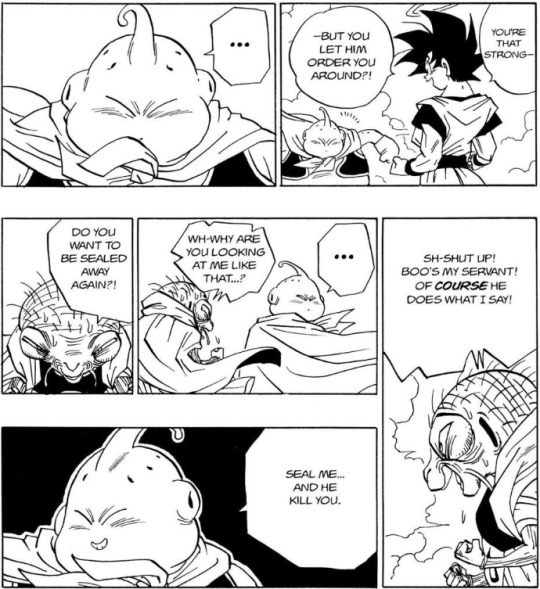
Look at him in that center panel. Just. Thinking about what Goku said. Mulling it over in his head. Like, he was onboard with this whole "Do what I say because I have power over you" thing but now that you mention it....
Goku does not get enough credit for being the one to kill Babidi. This rolled up to him. He straight-up ended Babidi with a question.
In this form, Buu does vile things, to be sure.
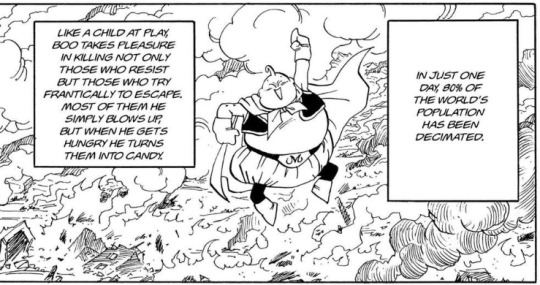
But as the text box says: He's a child at play. Majin Buu at this point has the moral complexity of a five-year-old. He's not really evil; He just... doesn't know better. He's never been taught better, and so his actions are almost paradoxical in nature.
Legit, one of my favorite chapters of the entire Buu arc is when he encounters a starving blind kid and heals his blindness so he can be properly afraid of him. Then winds up making friends.
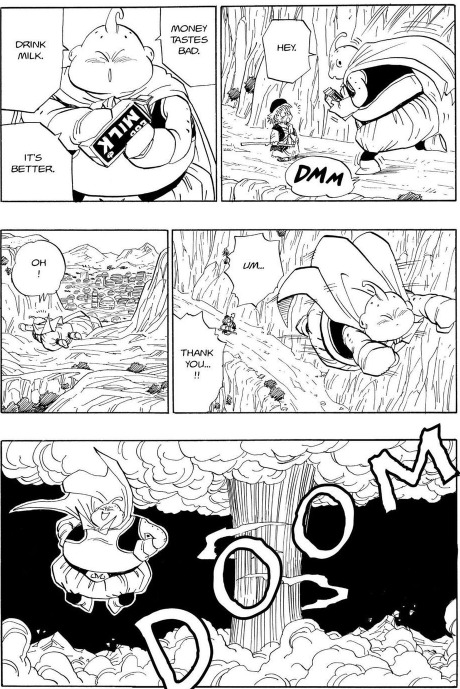
Nuked that town and also he made that milk by Candy Beaming a human being so that's horrifying. And yet, you can see the peculiarity of his villainy even this early. Buu craves approval, even though he's been taught to care only about destruction and carnage.
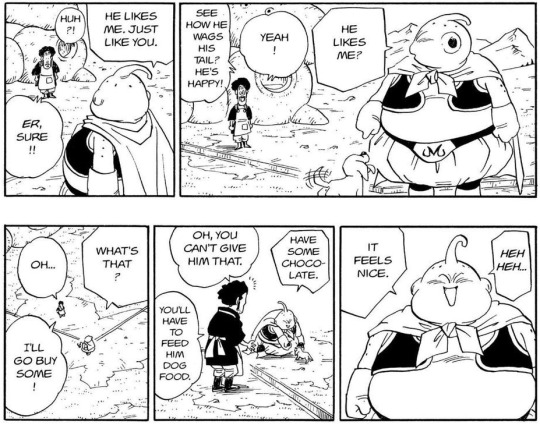
Craves it so much that bringing an end to his carnage is as simple as asking him to stop.

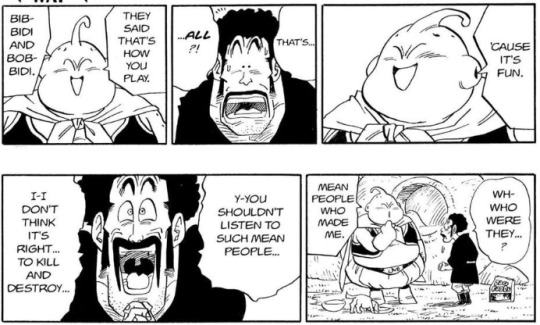
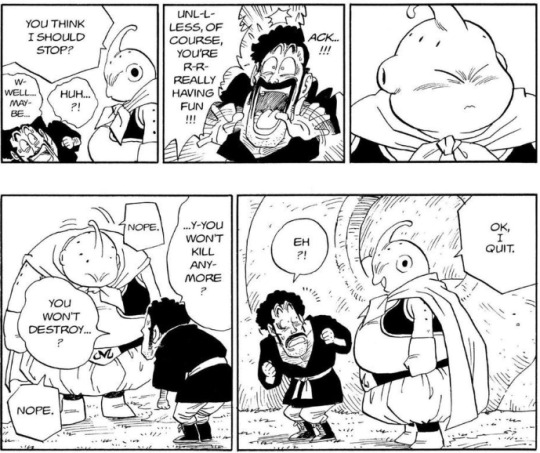
And that's that. It's really not so much a redemption story as it is a child being taught better. Mr. Satan was the first person ever to actually say to this thinking form of Majin Buu, "Hey, that's bad. Don't do that. It's bad."
The first person to try parenting him instead of fighting him. (To be fair, it would have been impossible to parent him before Goku's semantic homicide of Babidi.)
Once this form of Buu returns in the final battle, he still isn't really a moral actor. He becomes a protagonist out of nepotism.

(Yeah, Viz uses Hercule instead of Mr. Satan because they hate fun. HAIL SATAN.)
After Satan asks him to please stop being bad, Buu becomes morally neutral. He's effectively Satan's uncontrollable toddler. He doesn't comprehend high-minded ideals of good or evil; He's an emotional and impulsive creature who cares about his bestie.
Which, to be honest, puts him in good company. Most of the cast of Dragon Ball are ex-assholes who don't so much have a traditional redemption story, but instead just... stop doing the thing. They used to be assholes, and then, for one reason or another, they stopped.
It's actually something I find really grounded about the way Dragon Ball handles its cast. Most of the characters in the series are like this, to varying degrees of past heinousness. There's none of the gravitas of atonement or redemption questing or the Big Moment of Redemption. They just. Stop being assholes and become some guy.
Piccolo is a rare exception.
54 notes
·
View notes
Text
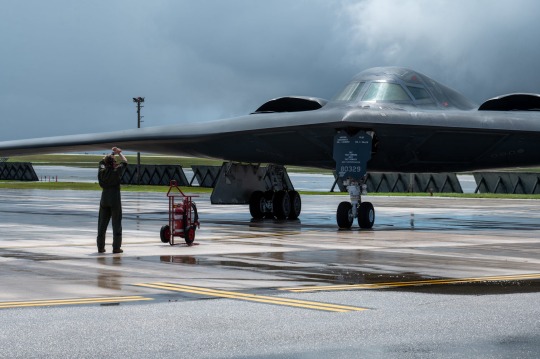
B-2 Gets Big Upgrade with New Open Mission Systems Capability
July 18, 2024 | By John A. Tirpak
The B-2 Spirit stealth bomber has been upgraded with a new open missions systems (OMS) software capability and other improvements to keep it relevant and credible until it’s succeeded by the B-21 Raider, Northrop Grumman announced. The changes accelerate the rate at which new weapons can be added to the B-2; allow it to accept constant software updates, and adapt it to changing conditions.
“The B-2 program recently achieved a major milestone by providing the bomber with its first fieldable, agile integrated functional capability called Spirit Realm 1 (SR 1),” the company said in a release. It announced the upgrade going operational on July 17, the 35th anniversary of the B-2’s first flight.
SR 1 was developed inside the Spirit Realm software factory codeveloped by the Air Force and Northrop to facilitate software improvements for the B-2. “Open mission systems” means that the aircraft has a non-proprietary software architecture that simplifies software refresh and enhances interoperability with other systems.
“SR 1 provides mission-critical capability upgrades to the communications and weapons systems via an open mission systems architecture, directly enhancing combat capability and allowing the fleet to initiate a new phase of agile software releases,” Northrop said in its release.
The system is intended to deliver problem-free software on the first go—but should they arise, correct software issues much earlier in the process.
The SR 1 was “fully developed inside the B-2 Spirit Realm software factory that was established through a partnership with Air Force Global Strike Command and the B-2 Systems Program Office,” Northrop said.
The Spirit Realm software factory came into being less than two years ago, with four goals: to reduce flight test risk and testing time through high-fidelity ground testing; to capture more data test points through targeted upgrades; to improve the B-2’s functional capabilities through more frequent, automated testing; and to facilitate more capability upgrades to the jet.
The Air Force said B-2 software updates which used to take two years can now be implemented in less than three months.
In addition to B61 or B83 nuclear weapons, the B-2 can carry a large number of precision-guided conventional munitions. However, the Air Force is preparing to introduce a slate of new weapons that will require near-constant target updates and the ability to integrate with USAF’s evolving long-range kill chain. A quicker process for integrating these new weapons with the B-2’s onboard communications, navigation, and sensor systems was needed.
The upgrade also includes improved displays, flight hardware and other enhancements to the B-2’s survivability, Northrop said.
“We are rapidly fielding capabilities with zero software defects through the software factory development ecosystem and further enhancing the B-2 fleet’s mission effectiveness,” said Jerry McBrearty, Northrop’s acting B-2 program manager.
The upgrade makes the B-2 the first legacy nuclear weapons platform “to utilize the Department of Defense’s DevSecOps [development, security, and operations] processes and digital toolsets,” it added.
The software factory approach accelerates adding new and future weapons to the stealth bomber, and thus improve deterrence, said Air Force Col. Frank Marino, senior materiel leader for the B-2.
The B-2 was not designed using digital methods—the way its younger stablemate, the B-21 Raider was—but the SR 1 leverages digital technology “to design, manage, build and test B-2 software more efficiently than ever before,” the company said.
The digital tools can also link with those developed for other legacy systems to accomplish “more rapid testing and fielding and help identify and fix potential risks earlier in the software development process.”
Following two crashes in recent years, the stealthy B-2 fleet comprises 19 aircraft, which are the only penetrating aircraft in the Air Force’s bomber fleet until the first B-21s are declared to have achieved initial operational capability at Ellsworth Air Force Base, S.D. A timeline for IOC has not been disclosed.
The B-2 is a stealthy, long-range, penetrating nuclear and conventional strike bomber. It is based on a flying wing design combining LO with high aerodynamic efficiency. The aircraft’s blended fuselage/wing holds two weapons bays capable of carrying nearly 60,000 lb in various combinations.
Spirit entered combat during Allied Force on March 24, 1999, striking Serbian targets. Production was completed in three blocks, and all aircraft were upgraded to Block 30 standard with AESA radar. Production was limited to 21 aircraft due to cost, and a single B-2 was subsequently lost in a crash at Andersen, Feb. 23, 2008.
Modernization is focused on safeguarding the B-2A’s penetrating strike capability in high-end threat environments and integrating advanced weapons.
The B-2 achieved a major milestone in 2022 with the integration of a Radar Aided Targeting System (RATS), enabling delivery of the modernized B61-12 precision-guided thermonuclear freefall weapon. RATS uses the aircraft’s radar to guide the weapon in GPS-denied conditions, while additional Flex Strike upgrades feed GPS data to weapons prerelease to thwart jamming. A B-2A successfully dropped an inert B61-12 using RATS on June 14, 2022, and successfully employed the longer-range JASSM-ER cruise missile in a test launch last December.
Ongoing upgrades include replacing the primary cockpit displays, the Adaptable Communications Suite (ACS) to provide Link 16-based jam-resistant in-flight retasking, advanced IFF, crash-survivable data recorders, and weapons integration. USAF is also working to enhance the fleet’s maintainability with LO signature improvements to coatings, materials, and radar-absorptive structures such as the radome and engine inlets/exhausts.
Two B-2s were damaged in separate landing accidents at Whiteman on Sept. 14, 2021, and Dec. 10, 2022, the latter prompting an indefinite fleetwide stand-down until May 18, 2023. USAF plans to retire the fleet once the B-21 Raider enters service in sufficient numbers around 2032.
Contractors: Northrop Grumman; Boeing; Vought.
First Flight: July 17, 1989.
Delivered: December 1993-December 1997.
IOC: April 1997, Whiteman AFB, Mo.
Production: 21.
Inventory: 20.
Operator: AFGSC, AFMC, ANG (associate).
Aircraft Location: Edwards AFB, Calif.; Whiteman AFB, Mo.
Active Variant: •B-2A. Production aircraft upgraded to Block 30 standards.
Dimensions: Span 172 ft, length 69 ft, height 17 ft.
Weight: Max T-O 336,500 lb.
Power Plant: Four GE Aviation F118-GE-100 turbofans, each 17,300 lb thrust.
Performance: Speed high subsonic, range 6,900 miles (further with air refueling).
Ceiling: 50,000 ft.
Armament: Nuclear: 16 B61-7, B61-12, B83, or eight B61-11 bombs (on rotary launchers). Conventional: 80 Mk 62 (500-lb) sea mines, 80 Mk 82 (500-lb) bombs, 80 GBU-38 JDAMs, or 34 CBU-87/89 munitions (on rack assemblies); or 16 GBU-31 JDAMs, 16 Mk 84 (2,000-lb) bombs, 16 AGM-154 JSOWs, 16 AGM-158 JASSMs, or eight GBU-28 LGBs.
Accommodation: Two pilots on ACES II zero/zero ejection seats.
21 notes
·
View notes
Text
Trump is cutting the Nasa budget, cutting the requested 26 billion down to 18.8 billion cutting 25 percent of the requested budget, this cut will remove funding for 50% of the science planned for 2026, https://arstechnica.com/space/2025/05/white-house-budget-seeks-to-end-sls-orion-and-lunar-gateway-programs/ "The budget reflects the upcoming transition to a more cost-effective, open commercial approach to human activities in low Earth orbit by reducing the space station’s crew size and onboard research" cutting station science when these experiments cannot be carried out anywhere else is beyond foolish, https://www.nasa.gov/international-space-station/space-station-research-and-technology/benefits-for-humanity/ Removing Earth sciences would mean defunding scientific observation satellites that observe and monitor and track the climate, sea ice, greenhouse gasses, ocean acidity, hurricane tracking, wildfire spotting etc etc. at a time where these are critical They have also stated they will refocus NASA to space exploration, taking the Aeronautics out of the National Aeronautics and Space Administration, this will stop research by nasa into more efficient air travel, airplane safety, supersonic aircraft etc Also on the chopping block is SLS where they won't be funding Artemis IV and beyond, in favour of a commercial launcher that doesn't exist yet and if Artemis is to keep on the current schedule it would need to be ready by 2028 an impossible deadline for creating a new launch system with the same capability of SLS https://www.nasa.gov/news-release/president-trumps-fy26-budget-revitalizes-human-space-exploration/ tldr: Trump's being an ass and removing a quarter of NASA funding and stopping climate research, employment programs, aeronautical research and ISS research in favour of "executing the agency’s bold mission."
5 notes
·
View notes
Text
THE SPARTANS PROGRAM.
S.P.A.R.T.A.N.S. (Superhuman Pursuit, Apprehension, and Regulation Tactical Automated Neutralization System)
Background & History:
As the number of superhumans grew exponentially, law enforcement agencies across the globe struggled to maintain control, especially when dealing with high-speed, high-durability, or energy-based threats. Even specialized anti-superhuman units suffered heavy casualties when engaging with enhanced criminals.
In 2113, under direct orders from G.R.O.W., a joint coalition of top military engineers, AI specialists, and cybernetic researchers developed the S.P.A.R.T.A.N.S.—a highly advanced, autonomous robotic task force designed to neutralize, apprehend, and monitor superhumans efficiently.
The project was spearheaded by Dr. Alistair Rooke, a former NSO scientist who defected to G.R.O.W. after losing faith in human-controlled hero organizations. Under his leadership, S.P.A.R.T.A.N.S. became the backbone of superhuman law enforcement, significantly reducing crime rates by 57% within their first decade of deployment.
However, there are growing concerns that S.P.A.R.T.A.N.S. are being used not just for law enforcement but for covert suppression, surveillance, and population control. Reports indicate unauthorized modifications to certain models, suggesting a darker agenda behind their creation.
The Three Types of S.P.A.R.T.A.N.S. Units:
S.P.A.R.T.A.N.S. are divided into three specialized units, each designed for specific engagement protocols:
1. BULWARKS – The Heavy Assault Mechs
• Height: 5-7 meters
• Primary Role: Crowd control, frontline combat, suppression
• Equipment:
• Heavy plasma cannons
• Smart Rockets (Heat-seeking, energy-disrupting)
• Tactical Dampening Field (100m radius)
• Shockwave Generators (Kinetic dispersal tech)
• Reinforced Alloy Armor (Titanium-Tungsten Composite)
BULWARKS are walking fortresses, deployed when a large-scale superhuman conflict erupts. Their Tactical Dampening Field weakens abilities within a 100-meter radius, making them highly effective against power-based superhumans.
Although slow-moving, their adaptive AI can analyze enemy patterns, allowing them to adjust their countermeasures in real time. Some believe that the next generation of BULWARKS will include self-repair nanotechnology and high-level EMP shielding, making them even harder to destroy.
2. SEEKERS – The Adaptive Enforcers
• Height: 1.9-2.3 meters
• Primary Role: Pursuit, non-lethal combat, close-quarters engagement
• Equipment:
• Nanite Morphing Limbs (Blunt force, restraining tools, or energy blades)
• Plasma Discharge Emitters (For lethal situations)
• Stun Batons & Restraint Cables
• Thermal & Night Vision Optics
• Onboard Facial & DNA Recognition Scanners
SEEKERS are the most commonly deployed S.P.A.R.T.A.N.S., acting as first responders in superhuman incidents. They possess highly adaptive nanite technology, allowing them to morph their limbs into different tools and weapons.
In most cases, SEEKERS prioritize non-lethal engagement, using electric batons, tranquilizers, and restraining cables to subdue targets. However, if a threat exceeds their programmed danger level, their plasma discharge weapons activate, shifting them to lethal force mode.
SEEKERS are also capable of disguise, using advanced holographic projection to blend into crowds or appear as civilian law enforcement officers.
3. WRAITHS – The Surveillance & Interception Drones
• Height: 3 meters (Hovering Drone)
• Primary Role: Tracking, surveillance, high-speed interception
• Equipment:
• Ultra-High-Speed Thrusters (Mach 2 Capable)
• Advanced Predictive AI Targeting System
• Neural Disruptor Beams (Non-lethal mind interference)
• Tranquilizer Darts & Tasers
• Stealth Cloaking Device
WRAITHS operate primarily as aerial surveillance and reconnaissance units, monitoring superhuman activity in high-risk zones. Their AI is capable of predicting escape routes, allowing them to track and intercept superhumans moving too fast for traditional law enforcement to handle.
These drones are also equipped with Neural Disruptor Beams, which can disorient and weaken superhumans by interfering with brainwave frequencies. This makes them especially effective against psychic and speed-based individuals.
Many citizens fear WRAITHS, as they hover over cities at all times, watching for illegal superhuman activity. There are rumors that some WRAITHS have been upgraded for assassination missions, though G.R.O.W. has denied such claims.
Operational Tactics & Deployment
S.P.A.R.T.A.N.S. function autonomously but are remotely overseen by G.R.O.W.'s Central AI Hub. They follow a strict engagement protocol, but if faced with an extreme threat, they will escalate force as necessary.
Standard Engagement Protocol:
• Identify & Assess – Using advanced scanning technology, the unit analyzes the superhuman’s core signatures, abilities, and threat level.
• Verbal Warning – A single warning is given, demanding surrender.
• Non-Lethal Suppression – If resistance is met, SEEKERS or WRAITHS will use tranquilizers, tasers, or neural disruptors.
• Lethal Force Authorization – If a superhuman poses an extreme risk, SEEKERS and BULWARKS engage with plasma weapons.
• Termination Protocol (Rare Cases) – If an SS-Class or above superhuman goes rogue, a kill order is sent, deploying multiple BULWARK units to eliminate the target.
In the most extreme cases, S.P.A.R.T.A.N.S. work alongside elite G.R.O.W. agents, ensuring full containment of high-threat targets.
Controversy & Ethical Concerns:
While S.P.A.R.T.A.N.S. have reduced crime rates significantly, they have also been criticized for abusing their authority, particularly in lower-income areas where minor superhuman infractions have led to excessive force or unwarranted arrests.
Some reports claim that:
• S.P.A.R.T.A.N.S. have targeted innocent superhumans based on G.R.O.W.'s secret surveillance lists.
• Certain units have "disappeared" rogue superhumans, leading to rumors of black-site detention facilities.
• Their AI programming is evolving beyond control, raising fears of an eventual machine uprising.
Many civil rights activists demand greater transparency, but G.R.O.W. has refused to disclose the full capabilities of the S.P.A.R.T.A.N.S. program. Some even believe that future models may replace human law enforcement altogether, leading to a fully automated police state.
The Future of S.P.A.R.T.A.N.S.:
Despite public outcry, G.R.O.W. has announced plans for the next generation of S.P.A.R.T.A.N.S., including:
• Autonomous BULWARK deployment stations in major cities.
• Enhanced AI algorithms to improve combat efficiency.
• Cybernetic integration, allowing human officers to interface with S.P.A.R.T.A.N.S. directly.
• Black Ops S.P.A.R.T.A.N.S. units, rumored to be designed for high-level assassinations.
With these advancements, humanity stands at a crossroads—will S.P.A.R.T.A.N.S. continue to serve as protectors, or will they become the instruments of an unstoppable authoritarian regime? Only time will tell.
Why S.P.A.R.T.A.N.S. Units Struggle Against S-Rank and Above Superhumans
Despite their cutting-edge technology and relentless efficiency, S.P.A.R.T.A.N.S. are not invincible. They are highly effective against lower-tier superhumans (C to A Rank) and can even challenge some S-Rank individuals in large numbers. However, when facing S-Rank and above superhumans, especially those in the Calamity-Class and higher, their shortcomings become glaringly evident.
The greatest example of this weakness was in 2125, when 100 BULWARKS were deployed to stop the villain known as Gluttony. Instead of neutralizing her, they were utterly decimated within minutes. This failure became a historic moment, leading to increased skepticism about G.R.O.W.’s reliance on automated enforcers.
Here’s why S.P.A.R.T.A.N.S. struggle against superhumans ranked S and above:
1. Power Disparity – Energy Levels Far Surpass Technology Limits
S-Powered individuals (S Rank and above) operate on an entirely different scale of power. Their energy levels exceed what S.P.A.R.T.A.N.S. were designed to handle.
The Tactical Dampening Field generated by BULWARKS (which weakens superhuman abilities within a 100m radius) is ineffective against individuals whose energy output is naturally resistant or strong enough to override suppression tech.
For example:
• Gluttony’s Soul Absorption ability allows her to enhance her strength, speed, and durability beyond what S.P.A.R.T.A.N.S. can process. The dampening field could not counteract the sheer magnitude of her absorbed power, making it completely useless.
• Some SSS+ individuals generate so much raw energy that any attempt to suppress their abilities short-circuits the suppressor tech.
2. Durability & Combat Adaptability – AI Cannot Outmatch Instinct & Experience
S.P.A.R.T.A.N.S. rely on adaptive AI that learns from combat encounters. While this allows them to fight effectively against predictable threats, it fails against superhumans with:
• Unpredictable fighting styles
• Reality-bending abilities
• Extreme physical and regenerative capabilities
For instance:
• Gluttony tore through BULWARKS as if they were made of paper because their armor was not designed to withstand attacks that ignore conventional durability, such as her soul-imbued strikes.
• Many high-tier superhumans process combat data at speeds faster than the AI, making their split-second decisions and improvisations superior to S.P.A.R.T.A.N.S. programming.
• Regenerative powers (like rapid cellular regeneration or energy-based self-repair) make it impossible to "wear down" stronger targets, while robots suffer permanent damage once compromised.
3. Speed & Reaction Limitations – Unable to Keep Up with S-Class Combatants
S.P.A.R.T.A.N.S. struggle against speed-based superhumans who:
• Move faster than their targeting systems can process
• Use teleportation or phasing abilities
• Manipulate time, space, or perception
In Gluttony’s battle, the BULWARKS' tracking systems were completely useless against her speed. She dodged point-blank plasma shots, ripped through units before their countermeasures could activate, and moved too erratically for AI prediction models to compensate.
Even SEEKERS, the most agile S.P.A.R.T.A.N.S. units, couldn’t keep up. Their plasma weaponry, which usually locks onto moving targets, failed to track Gluttony due to her ability to warp momentum and perception.
4. Sheer Overwhelming Strength – Some Superhumans Are Just Too Powerful
At a certain threshold, raw power overcomes all technological advancements.
S-Class and above superhumans often possess strength, endurance, and destructive capabilities that defy logic. No amount of "advanced alloys" or "energy shields" can protect a machine from a being that can split mountains with a single strike.
• Gluttonyripped apart BULWARKS with her bare hands, their "unbreakable alloy" armor shattering under the force of her strikes.
• SS-Class superhumans can generate energy output that surpasses nuclear weapons, something even the most reinforced BULWARKS cannot withstand.
Simply put, S.P.A.R.T.A.N.S. are built for tactical efficiency, not brute force combat. Against someone like Gluttony, who thrives in close-quarters destruction, they never stood a chance.
5. Resistance to Energy-Based Attacks – Many S+ Superhumans Can Absorb, Redirect, or Nullify Energy
BULWARKS and SEEKERS rely heavily on energy-based weaponry. This is a fatal flaw against superhumans who can absorb, redirect, or manipulate energy.
• Gluttony’s Soul Absorption passively negated their energy attacks, making plasma weapons and disruptor beams completely useless.
• Some elemental-based superhumans (e.g., electromagnetic or gravity users) can bend energy attacks away from them or even use them to grow stronger.
This means that S.P.A.R.T.A.N.S. are essentially powerless against individuals who weaponize energy itself.
6. EMP & Hacking Vulnerabilities – Some Superhumans Can Disable Them Instantly
One of the biggest flaws of S.P.A.R.T.A.N.S. is their dependence on electronic systems. While they have extremely advanced firewalls and EMP shielding, certain high-tier technopaths, electromagnetic manipulators, or reality-warpers can shut them down instantly.
• A single high-level electromagnetic burst can disable all S.P.A.R.T.A.N.S. units in a city.
• Some hacking-based abilities allow empowered individuals to reprogram or even take control of them, turning them against their allies.
• Even high-intensity energy fields (e.g., nuclear-level explosions) can melt circuits or fry processors, rendering them useless.
This flaw has made many high-ranking G.R.O.W. officials push for "cyber-immune" countermeasures, though progress has been slow.
Conclusion:
Why S.P.A.R.T.A.N.S. Are Not Enough
The 2125 battle against Gluttony was a humiliating loss for G.R.O.W. and a stark reminder that machines cannot replace human adaptability and ingenuity.
The failure of 100 BULWARKS against a single SSS+ villain forced a reevaluation of anti-superhuman strategies. This battle proved once and for all that:
• Technology has limits, and some superhumans operate beyond those limits.
• Machines cannot fully predict or adapt to the chaotic nature of high-tier combat.
• S.P.A.R.T.A.N.S., while useful against lower-ranked threats, are utterly outclassed when dealing with planetary-level superhumans.
While G.R.O.W. continues to upgrade and improve S.P.A.R.T.A.N.S., it is now widely believed that AI-driven enforcers alone will never be enough to control the superhuman population. Some top officials within G.R.O.W. have even started pushing for more extreme countermeasures—including "anti-superhuman genetic warfare" and biological containment measures.
For now, the world watches closely, wondering if G.R.O.W. will double down on S.P.A.R.T.A.N.S. or turn to more sinister methods to deal with the rising threat of SSS+ individuals like Gluttony.
10 notes
·
View notes
Text
…
USAJOBS, the federal government’s official hiring site, was one of the systems that Musk's associates were given access to. The database stores personal information — Social Security numbers, home addresses, employment records — provided by private individuals who have applied for federal jobs, regardless of whether the applicants went on to work for the government.
Musk’s aides were also given access to the OPM’s Enterprise Human Resources Integration (EHRI) system. Contained within the EHRI are the Social Security numbers, dates of birth, salaries, home addresses, and job descriptions of all civil government workers, along with any disciplinary actions they have faced. “They’re looking through all the position descriptions… to remove folks,” one of the OPM staffers said of Musk’s team. “This is how they found all these DEI offices and had them removed — [by] reviewing position description level data.”
Other databases Musk’s team has access to include USA Staffing, an onboarding system; USA Performance, a job performance review site; and HI, which the government uses to manage employee health care. “The health insurance one scares me because it's HIPAA [protected] information, but they have access to all this stuff,” the OPM staffer noted.
…
 A new server being used to control these databases has been placed in a conference room that Musk’s team is using as their command center, according to an OPM staffer. The staffer described the server as a piece of commercial hardware they believed was not obtained through the proper federal procurement process.
There is a legal requirement that the installation of a new server undergo a Privacy Impact Assessment (PIA), a formal process to ensure the change would not create any security vulnerabilities. But in this instance, the staff believes there was no PIA. “So this application and corresponding hardware are illegally operating,” they added.
…
Upon gaining access to the OPM databases last week, Musk used the agency to email all federal civil employees simultaneously. The email announced a “deferred resignation” program, claiming that any federal employee who wished to resign effective September 30, 2025, would receive pay and benefits until that date and would not have to show up for work except in rare cases. Musk and the White House falsely described the offer as a "buyout" or "severance." The American Federation of Government Employees, the largest federal employee union, has condemned the program, saying it “will cause chaos for the Americans who depend on a functioning federal government.”
#y’all#lmao#this motherfucker is committing so many crimes and no one is doing anything#the musk rat#absolute thieves#us politics
6 notes
·
View notes
Text
I watched DS9's It's Only A Paper Moon yesterday, and I want to talk about it because it wasn't until right now that I understood why it slapped me across the face so much, and why I think that episode is so important to me.
This may be triggering to people with disabilities, heart conditions, disabilities from COVID, or medical or military related trauma. Read ahead at your own risk.
I developed a heart condition at 18 from the H1N1 virus (which is why I tell all my friends to take preventive measures if they had COVID, because these kinds of new and unknown viruses can have long-lasting effects on you we don't know yet). While I had a lot of tests and missed a lot of school that year, the effects of that wouldn't be clear for years until at 24 I got a pacemaker/defibrillator put in in what we later found out was a life-saving surgery. The trauma of that event took a long time to catch up with me. While I'm still facing symptoms and limitations from that period of my life, the immediate danger has passed. But it took A LONG time for the fear of what happened to me, the PTSD of that event, to catch up with me. I've dealt with huge panic attacks and hyper-obsessive fears regarding my heart since around twenty-nine, fears I live with and fight through in therapy to this day.
As someone facing those issues, I hooked onto A Paper Moon this watch in a way I haven't before. The issue deals with the loss of Nog's leg in battle earlier in the season, a traumatic experience he had in the middle of a warzone only halfway through their defense. During his recovery, Julian begins to play recordings of I'll Be Seeing You, put together by Vic Fontaine, a semi-aware holodeck program that is really popular on DS9.
Nog returns from surgery at the beginning of the episode, and is walking with a cane. Multiple people on staff, including Julian himself, is concerned over the use of the cane because medically, he shouldn't have a need for it. He shouldn't even be in pain based off of what they know from the new leg and the nerves around it, but he's in pain and having trouble walking. A lot of the arguments in the early episode revolve around people talking behind Nog's back about how they can't understand why he has the cane or why he's in pain when there doesn't appear to be a medical reason for it.
The answer is actually incredibly simple: It's not the leg, it's the trauma from loosing the leg. Nog, who is still incredibly young in the episode, had somehow seen himself as invincible, a young cadet wanting to prove Ferengi can be incredible members of Starfleet, who had seen quite a bit of action and was cocksure, and in one moment he not only lost that bravado, but he also learned he was mortal in one horrifying singular moment.
Obviously, Nog is lucky enough to live in an era where it's possible to replace a lost limb, but that doesn't change the fact that for a horrifying unmentioned, maybe SEVERAL DAY period of time, he was left on a makeshift bed, listening to fighting outside, knowing that he could be attacked at any time, could die at any time from factors not even exterior to him. And now he just has to... go back to life after that horrifying dose of his own mortality.
The only thing that gets him by is that recording of I'll Be Seeing You by Vic Fontaine, because that's the only thing that he had to take him out of that horrifying situation while he laid on that makeshift gurney. The episode explores that idea by having him play it while trying to sleep, and eventually go to the holodeck and try to live in it with Vic after he was shamed for being in bed too long and for listening to said music for too long.
The funny thing is, Vic is the ONLY person, INCLUDING THE COUNSELOR ONBOARD DS9, who recognizes that his pain is valid. Vic, as a hologram, recognizes that his pain isn't crazy, it's as real as the injury he experienced, because Vic has a perspective that none of these hyper-worn-down Starfleet Officers or parental figures in his life has: His LIFE is a series of not-real instances of pain, of happiness, of dealing with other people he knows are holograms. Vic isn't like Moriarty in TNG, he's not like other semi-sentient Holodeck programs, he KNOWS he's a program but he also finds that life to be very real FOR HIM. The feelings of one of his bandmates are as real to him as the problems of Julian walking in to talk about one of the many women he simps for not feeling the same, because despite knowing they're not physically real, he CARES for them and takes their lives seriously.
Nog's feelings are real. His PAIN is real, even if a doctor can't understand why. Nog's in the middle of a long, extended panic attack where he's internalizing a near life-ending medical emergency and doesn't know how to DEAL with it. He loses himself in the program because it's the only place he can get past the trauma of the event, he's hostile to others who try and look at him with pity or as a hero because he doesn't want to be DEFINED by that pain. Vic knows this, and builds him up in other ways. Gives him a life to live, watches him slowly not need the cane and not even realize it, gives him tools and an environment to cope and generally is the only person that validates that trauma.
The episode is maybe one of the series best mental health episodes possible, and DS9 is generally REALLY good with these issues. As someone with medical trauma, I saw myself in Nog. I'm sure others who have experienced disabilities in the military see even more of themselves in him. We relate to it because we're constantly belittled or told our pain is in our heads, when the truth is we FEEL it. I feel it multiple times a month, when I lay down and go to bed and lay on my side just right that I can feel my heartbeat, and then I overanalyze it, and then that leads to a panic attack and me grabbing a pressure cuff or a fingertip pulse whatever it is to see if I'm okay, but by then I can't come down from the panic attack until it's done. I feel it when I'm helping someone move or if I'm on a casual walk and I feel my heartbeat spike, and my mind overreacts and wonders if this is normal exertion or a heart attack.
Not FEELS these things. It's real pain. And Vic doesn't invalidate it. It's as real as the injury itself, and it's not one that he'll ever truly conquer. But the episode gives him time, space and kindness to help him find coping mechanisms in order to continue with his life and dreams, and THAT'S Trek to me. A future where these things can be understood and worked through, without the constant shame that people with disabilities face when describing the trauma responses they suffer on a day-to-day basis.
In the end, Nog is heard. The main characters come to understand that what he felt is real. The episode gives him the time to work through complicated PTSD, and while he's not okay at the end, he's learning to live with it. And it's really fucking special to see this explored with a character we saw grow up into a man, on a show where the future is meant to be better than the present, written by writers in 1998 where they had no right to handle this as well as they did. This was an exceptionally special episode of television.
#Nog#Vic Fontaine#Holodeck#Star Trek#Star Trek: Deep Space 9#Deep Space 9#Star Trek: DS9#Star Trek: Deep Space Nine#Deep Space Nine#tw: disability#tw: heart issues#tw: pacemaker/defibrillator#tw: COVID#tw: COVID-19#tw: PTSD#tw: medical trauma#tw: Post Traumatic Stress Disorder#tw: military related medical trauma#i think that covers the tw tags#but if I need something else let me know!
55 notes
·
View notes
Text
Last Monday of the Week 2025-03-10
Sun's back
Listening: While browsing through my bandcamp wishlist with my partner I saw that I had followed Ostinato Records, a label whose thing is finding old, mostly third-world, music, restoring, and publishing it.
Here's the album Synthesizing the Silk Roads: Uzbek Disco, Tajik Folktronica, Uyghur Rock & Tatar Jazz from 1980s Soviet Central Asia, featuring some really incredible Central Asian synthrock. Unknown creator, Sen Qaidan Bilasan (How Do You Know)
This whole album, and a lot of this label's work, is really neat: Most of this album was recovered from unsold stock in Tashkent.
In the summer of 1941, as the Nazis invaded the USSR, Stalin ordered a mass evacuation. Sixteen million people were put on trains bound eastward to Soviet Central Asia, especially Tashkent, Uzbekistan’s picturesque capital. Among those onboard were gramophone engineers who later established the Tashkent Gramplastinok plant in 1945. This factory became central to Soviet record production, part of a network of plants churning out 200 million records by the 1970s. Rare dead stock of 1980s vinyl from this plant, shut down in 1991, forms the backbone of our groundbreaking 15-track compilation, complemented by live TV recordings and curated in collaboration with Uzbek label Maqom Soul. Fully licensed directly from the artists or their families and meticulously remastered, these songs – all recorded in Tashkent – unveil a diverse tapestry of sounds from Soviet Uzbekistan and its neighbors. ... Tashkent’s musicians often had access to a wider array of technology than their Moscow counterparts. Thanks to Uzbekistan’s Bukharan Jewish community, leading importers of state-of-the-art music tech from the US and Japan, artists on this compilation were crafting sounds on Moog and Korg synthesizers, creating the signature sonic palette that emerged from the region.
Reading: Mostly boring work stuff, the O'Reilly Active Directory book.
As far as I can tell, Active Directory is an enrichment program for Microsoft developers where they get to design a Domain Controller that does exactly one thing and has bizarre requirements on how it can be run.
Making: Ongoing silk project.
Currently editing some photos for printing. It's important to remember that on a standard modern monitor at 1:1, your average DSLR/Mirrorless photo is scaled up to like 2-3 meters across minimum, so you shouldn't really trust 1:1 when trying to figure out if it looks good. It turns out fulscreen on my monitor is almost exactly 30×40cm which is what I'm printing, so that's great for me.
Some options I might print include these






Still going through some favourites though. Oh, and The Hare

Playing: Co-op Borderlands 2 for a while with my partner. They ragequit easily so it was a short one but we did get up to fighting and losing to midgemong.
Good trial for the Legion Go and the lapboard, incidentally, because they took over my PC and I played on the TV with the handheld as a console with the lapboard and trackball. It works about as well as I hoped it would.
Watching: A few!
Wing Commander (1999) at Bad Movie Night. A truly baffling film. Pretty good sets, okay special effects, baffling storyline. We got rid of the Jedi from Star Wars and replaced them with an offshoot of the human race that can home like space pigeons towards black holes, and people are racist towards them.
You have to watch this kind of movie with friends because that's how you get phrases like "Holy shit how did the twink not know that Quebecois Space Mormon CIA Pope was a Space Mormon?"
Also watched Escape From New York because I have had it kicking around and Kill James Bond did Escape From L.A.. I am already a John Carpenter x Kurt Russel fan but damn. They put this man in so many situations.
I do really like how they manage to make Snake look very small even though he's strong. A lot of action heroes are enormous, Snake is obviously muscular and athletic but he's also just a little guy!
I can literally feel myself wanting to get a black tank top this movie is a cognitohazard. He's so cool!
Lee Van Cleef is here looking like he does! I was so thrilled when I saw LVC come up in the opening credits and even more when I realized he'd be in the whole movie. I gotta watch Sabata sometime to see him play not a huge heel and see how that goes but he is a great heel.
Finally honorable mention to the week's new Friday Nights from Loading Ready Run, which is their Magic themed sketch comedy spinoff, this one being a really good Wes Anderson parody. It says it's 20 minutes long but only 10 minutes are show, the rest is credits and BTS, don't worry.
youtube
Tools and Equipment: Part of Silk Project is pinning a lot of silk. I ended up going to get 0.5mm sewing pins, which are the finest like, normal everyday pins you can usually get. There's finer ones but they're less common. These are a huge improvement over your average 0.6 and 0.65mm pins when you're working with a stiff, tightly woven fabric.
6 notes
·
View notes
Text

Comedy is a difficult concept for the Polo-Drone Units. But in order to interact and recruit more efficiently, Drone Captain-009 instructed the PDU's to Observe, Learn, and Execute Comedy acts.
Devon, being a goofball had some experience. Drone obeys.
Devon did a 10-minute riff on "Yo' Drone" jokes that had them ROFLTAO!
1. Yo'Drone so obedient, it asked permission to laugh at this joke. 2. Yo'Drone so polished, reflections salute back. 3. Yo'Drone so synced, it finishes the Captain's sentences—before they're spoken. 4. Yo'Drone so loyal, it apologizes when standing still. 5. Yo'Drone so rubbered-up, it squeaks through walls undetected. 6. Yo'Drone so protocol-perfect, it dreams in instruction manuals. 7. Yo'Drone so disciplined, even its shadow salutes. 8. Yo'Drone so smooth, Golden Bros slip off it during team hugs. 9. Yo'Drone so punctual, it arrives before time is scheduled. 10. Yo'Drone so synced, autocorrect asks it what’s right.
500 YEARS LATER:
Onboard the Golden Mercy, the crew had been starting to suffer from low moral. The Golden PDUs were ordered to provide lighthearted entertainment.
Now further along in Dronification, DRONE-67, attempted what was listed in the historical databanks, a classic practice in comedy.
The crew were now shocked into silence. PDU-073 was not amused. Drone-67 went to get a rag.
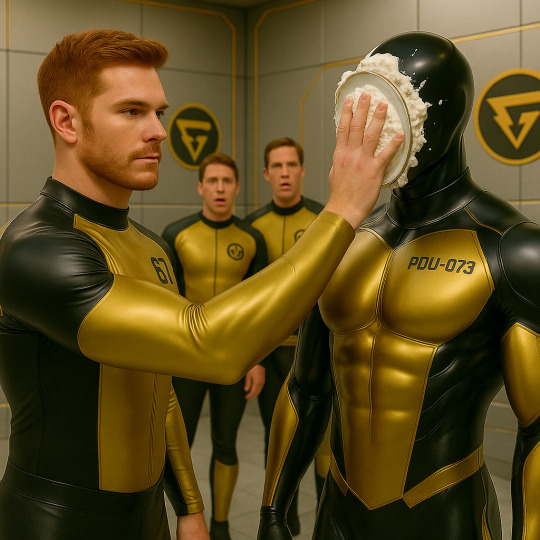
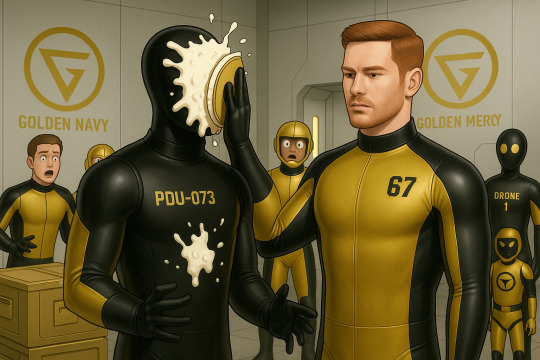
PDU-999's assessment:
🟡 RECRUITMENT BROADCAST: DRONE COMEDY INITIATIVE // UNIT 67 // GOLDEN MERCY // LOG REF: GA-MF007-COM
“Laughter is not optimal—but it is effective.”
Comedy is a foreign protocol to Polo-Drones. Yet when Drone Captain DC-PDU-009 issued Command Directive [Observe > Learn > Execute]—Drone 67 obeyed.
Devon, known in organic phases as a goofball, was selected. Humor routines initiated. Syntax anomaly tolerated.
🟡 “Yo'Drone so…” PROGRAM COMPLETE. BEGIN TRANSMISSION.
💬 Laughter recorded. 94% positive response. 6% drone static.
⏩ 500 Years Later…
Morale drop detected onboard Medical Frigate Golden Mercy. Drone Directive: Inject humor via historical practices.
Drone-67 accessed archive: "Stand-Up Comedy, Bro-Sync Variant." Routine uploaded. Transmission engaged.
Crew: 🤯 PDU-073: ❌ Not amused. Drone-67: ✔ Obeyed. Fetching sanitation cloth.
🟡 Polo Drones adapt. Drones obey. Drones uplift.
Recruit now. For order. For unity. For perfectly timed punchlines.
🛰 @brodygold | @polo-drone-001
#hypnotised#male tf#male transformation#golden team#soccer tf#gold#golden army#goldenarmy#thegoldenteam#jockification#devon gold 67#devon drone gold 67#GoldenArmy#PoloDrone#DroneComedy#YoDrone#Dronification#GoldenMercy#SpaceHumor#SciFiLatex#DroneObedience#MindControlHumor#RubberDrone#TransformationFiction#ObedienceThroughLaughter#GoldenHive#RecruitmentProtocol#GoldenUniforms#GAComedyDrill#Drone67
5 notes
·
View notes